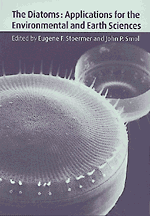Book contents
- Frontmatter
- Contents
- Contributors
- Preface
- Part I Introduction
- Part II Diatoms as indicators of environmental change in flowing waters and lakes
- 2 Assessing environmental conditions in rivers and streams with diatoms
- 3 Diatoms as indicators of hydrologic and climatic change in saline lakes
- 4 Diatoms as mediators of biogeochemical silica depletion in the Laurentian Great Lakes
- 5 Diatoms as indicators of surface water acidity
- 6 Diatoms as indicators of lake eutrophication
- 7 Continental diatoms as indicators of long-term environmental change
- 8 Diatoms as indicators of water level change in freshwater lakes
- Part III Diatoms as indicators in extreme environments
- Part IV Diatoms as indicators in marine and estuarine environments
- Part V Other applications
- Part VI Conclusions
- Glossary, and acronyms
- Index
7 - Continental diatoms as indicators of long-term environmental change
Published online by Cambridge University Press: 16 January 2010
- Frontmatter
- Contents
- Contributors
- Preface
- Part I Introduction
- Part II Diatoms as indicators of environmental change in flowing waters and lakes
- 2 Assessing environmental conditions in rivers and streams with diatoms
- 3 Diatoms as indicators of hydrologic and climatic change in saline lakes
- 4 Diatoms as mediators of biogeochemical silica depletion in the Laurentian Great Lakes
- 5 Diatoms as indicators of surface water acidity
- 6 Diatoms as indicators of lake eutrophication
- 7 Continental diatoms as indicators of long-term environmental change
- 8 Diatoms as indicators of water level change in freshwater lakes
- Part III Diatoms as indicators in extreme environments
- Part IV Diatoms as indicators in marine and estuarine environments
- Part V Other applications
- Part VI Conclusions
- Glossary, and acronyms
- Index
Summary
Introduction
It is curious that diatoms, whose short lifespans and capacity for rapid regeneration make them especially suitable for short-term paleoenvironmental studies, would also have a significant role as indicators of long-term environmental change. This chapter explores the nature of long diatom records, their relation to global environmental changes, guidelines for their interpretion, and problems common to such records.
Definitions and concepts
To examine the use of continental diatoms as proxies of long-term environmental change, it is first necessary to define what is meant by ‘long-term’. ‘Long’ for this paper refers to lake records that encompass several glacial / interglacial cycles (e.g., IGBP, 1992). At a minimum, long records reach the preceding interglacial, the Eemian or Sangamon, and correlate to the marine oxygen isotope stage 5e, about 125000 years ago.
It is also relevant to discriminate between ‘long-term environmental change’ as opposed to short-term environmental changes that have occurred over long time periods. Long-term environmental change results from processes which operate along uninterrupted trends of thousands or millions of years. Only three basic processes actually operate at this scale: (i) Deep-seated lithosphere convection caused by radioactive decay that drives continental drift, tectonism and volcanism; (ii) Variations in orbital relations between the earth and sun that govern insolation and long-term climate change; (iii) Slowing of the earth's rotation and the increasing distance between earth and moon; very long-term (109 years) changes irrelevant to the scope of this chapter.
- Type
- Chapter
- Information
- The DiatomsApplications for the Environmental and Earth Sciences, pp. 169 - 182Publisher: Cambridge University PressPrint publication year: 1999
- 11
- Cited by



